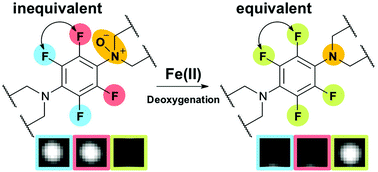A 19F-MRI probe for the detection of Fe(ii) ions in an aqueous system†
Abstract
Iron deposits are often observed in the brains of patients with neurodegenerative diseases, including Alzheimer's and Parkinson's diseases. This study outlines the development of F-Nox-1 as the first example of a 19F-MRI probe that can selectively detect Fe(II) in aqueous solutions. The use of tetrafluoro-p-phenylenediamine (TFPDA) as a 19F signal emitter with an Fe(II)-selective chemical switch, based on our previously reported N-oxide chemistry, yielded a readout of a symmetry-dependent 19F signal change in response to Fe(II). The addition of Fe(II) ions to F-Nox-1 triggered a 19F signal change, both in the chemical shift and signal intensity, and the response was highly selective to Fe(II) over other biologically relevant metal ions. The probe could also detect Fe(II) in serum containing various biological contaminants by 19F magnetic resonance imaging (19F-MRI). Imaging of soluble Fe(II) species, which is the major component of water-soluble iron species, by 19F-MRI will potentially enable the direct monitoring of the elevation of Fe(II) levels prior to the formation of iron deposits, which is a potential risk factor for neurodegenerative diseases.

- This article is part of the themed collection: Chemical Biology in OBC


 Please wait while we load your content...
Please wait while we load your content...